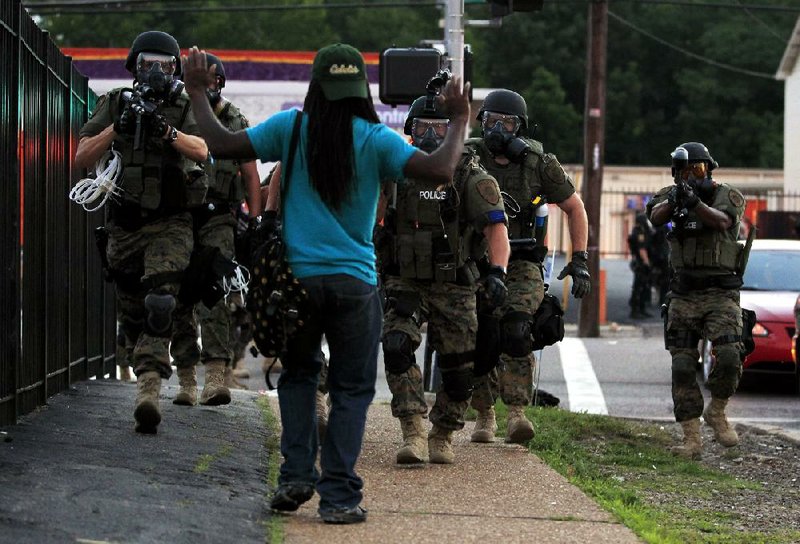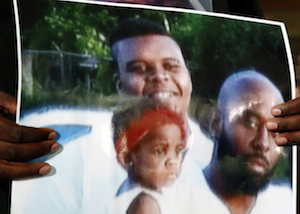FERGUSON, Mo. -- In another day of demonstrations, protesters chanting "Don't shoot" marched in front of the St. Louis County prosecutor's office Tuesday, demanding the arrest of a police officer who shot and killed an unarmed black teenager.
The Ferguson Police Department, which had previously said it would release the name of the officer, said Tuesday that it had decided against doing so out of concern for the safety of the officer, who was put on administrative leave. The department said threats had been made against the city's police on social media.
"The value of releasing the name is far outweighed by the risk of harm to the officer and his family," Ferguson Police Chief Thomas Jackson said.
The officer has been with the force for about six years and was on a routine patrol when he encountered the two young men, Jackson said. Police have not disclosed the race of the officer, but witnesses said he was white.
The latest demonstration -- this one in Clayton, Mo., the St. Louis County seat -- attracted about 150 people who waved signs, shouted slogans and raised their hands over their heads in a pose adopted by protesters during three days of sometimes violent protests and looting, which have rocked the St. Louis area since Saturday's shooting.
The circumstances surrounding the shooting of the teenager, Michael Brown, 18, as he and a friend walked from a convenience store, are in dispute. Police said he hit the officer who shot him, while his family and friends denied that.
In a local television interview, the friend who was walking with him, Dorian Johnson, said the officer opened fire when the young men refused to move from the middle of the street to the sidewalk. He said Brown's hands were over his head. Authorities said Brown was shot a number of times.
On Monday, the FBI opened a civil-rights inquiry into the shooting, and the case is also being investigated by St. Louis County prosecutors. The results of an autopsy on Brown have not yet been released.
Tuesday's protest lasted more than an hour, with about a dozen men approaching officers with their hands up saying, "Don't shoot me." At least 100 police officers were on the scene, shining bright lights into the crowd and telling people to return to their homes. At least 12 people were arrested.
At one point, the sound of gunfire was heard from within the area where the police had barricaded streets in Ferguson. Earlier in the night, several people threw rocks at officers.
Jackson of the Ferguson Police Department said the officers used tear gas and shot "beanbag rounds" after rocks were thrown at officers and gunfire came from the crowd.
Also Tuesday, the Internet and phones went down at Ferguson's City Hall after an international group of computer hackers known as Anonymous warned Monday in a video on Twitter that it would "take every Web-based asset of your departments and federal agencies offline" if police officers were to "abuse, harass or harm" protesters.
City officials didn't say what happened Tuesday -- only that a flood of traffic aimed at the city's website "just kept coming."
The hackers also warned Monday that they would begin publicly releasing police officers' personal information.
Early Tuesday morning, someone posted the home address and phone number of Jon Belmar, the relatively new chief of the St. Louis County Police Department, along with photos purporting to show his house and his family.
The shooting mobilized supporters, including Cornell Williams Brooks, the president of the NAACP, who flew into St. Louis on Monday. He said he was committed to seeking justice.
"Note that he [Brown] was nonviolent," Brooks said. "If you want to honor his memory, honor his memory by seeking justice nonviolently."
On Tuesday, civil-rights leader the Rev. Al Sharpton also pleaded for calm while pressing police to release the name of the officer who fatally shot the teen.
"The local authorities have put themselves in a position -- hiding names and not being transparent -- where people will not trust anything but an objective investigation," Sharpton, standing with Brown's parents, said during a news conference in St. Louis.
President Barack Obama also released a statement urging calm, saying people must comfort each other "in a way that heals, not in a way that wounds."
Ferguson, a city of 21,000 northwest of St. Louis, has shifted substantially over the past decade, with blacks, once a minority, now making up two-thirds of the residents after many white families moved to surrounding suburbs. The town's leadership and the police have remained predominantly white.
Information for this article was contributed by Julie Bosman, Timothy Williams, Erica Goode, Emma G. Fitzsimmons, D.J. Wilson and Alan Blinder of The New York Times; by Alan Scher Zagier, David Lieb and Jim Suhr of The Associated Press; and by David Hunn and Joel Currier of the St. Louis Post-Dispatch.
A Section on 08/13/2014
26511539


